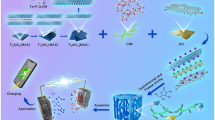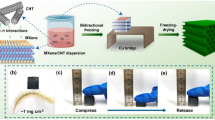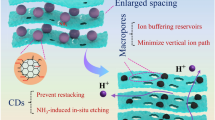Abstract
Three dimensional (3D) porous graphene decorated with MoO2 nanoparticles were successfully synthesized by hydrothermal method and characterized by SEM and TEM, x-ray diffraction, Raman spectra, x-ray photoelectron spectroscopy, nitrogen adsorption–desorption analysis and electrochemical experiments. The results revealed that the in situ formed monoclinic MoO2 nanoparticles were randomly decorated on the surface of graphene sheets and the obtained graphene–MoO2 nanohybrids were 3D porous structures. The mass ratio of molybdenum precursor with GO has effects on the specific surface area and the electrochemical properties of the nanocomposite. The M30G1 (the mass ratio of molybdenum precursor with GO was 30:1) composite electrode exhibited a higher specific capacitance and better cycling stability. The specific capacitances were 356 F/g at the current density of 0.1 A/g in KOH electrolyte, which predicted their potential application in energy storage. The electrochemical performance of M30G1 composite was also investigated in Na2SO4 electrolyte, which was poorer than that in KOH electrolyte. Therefore, the chosen of electrolyte is important to materials performance.







Similar content being viewed by others
References
G. Wang, L. Zhang, and J. Zhang: A review of electrode materials for electrochemical supercapacitors. Chem. Soc. Rev. 41, 797 (2012).
Y. Huang, J. Liang, and Y. Chen: An overview of the applications of graphene-based materials in supercapacitors. Small 8, 1805 (2012).
Y. Shao, M.F. El-Kady, L.J. Wang, Q. Zhang, Y. Li, H. Wang, M.F. Mousavi, and R.B. Kaner: Graphene-based materials for flexible supercapacitors. Chem. Soc. Rev. 44, 3639–3665 (2015).
S. Patil, A. Harle, S. Sathaye, and K. Patil: Development of a novel method to grow mono-/few-layered MoS2 films and MoS2–graphene hybrid films for supercapacitor applications. CrystEngComm 16, 10845 (2014).
N. Gao and X. Fang: Synthesis and development of graphene–inorganic semiconductor nanocomposites. Chem. Rev. 115, 8294 (2015).
A. Prakash and D. Bahadur: The role of ionic electrolytes on capacitive performanceof ZnO–reduced graphene oxide nanohybrids with thermally tunable morphologies. ACS Appl. Mater. Interfaces 6, 1394 (2014).
Y. Wang, P. He, W. Lei, F. Dong, and T. Zhang: Novel FeMoO4/graphene composites based electrode materials for supercapacitors. Compos. Sci. Technol. 103, 16 (2014).
Y. Li, N. Zhao, C. Shi, E. Liu, and C. He: Improve the supercapacity performanceof MnO2-decorated graphene by controlling the oxidization extent of graphene. J. Phys. Chem. C 116, 25226 (2012).
A.R. Marlinda, N.M. Huang, M.R. Muhamad, M.N. An’amt, B.Y.S. Chang, N. Yusoff, I. Harrison, H.N. Lim, C.H. Chia, and S.V. Kumar: Highly efficient preparation of ZnO nanorods decorated reduced graphene oxide nanocomposites. Mater. Lett. 80, 9 (2012).
Y. Liu, Y. Jiao, Z. Zhang, F. Qu, A. Umar, and X. Wu: Hierarchical SnO2 nanostructures made of intermingled ultrathin nanosheets for environmental remediation, smart gas sensor, and supercapacitor applications. ACS Appl. Mater. Interfaces 6, 2174 (2014).
F. Huguenin and R.M. Torresi: Investigation of the electrical and electrochemical properties of nanocomposites from V2O5, polypyrrole, and polyaniline. J. Phys. Chem. C 112, 2202 (2008).
W.J. Yu, P.X. Hou, L.L. Zhang, F. Li, C. Liu, and H.M. Cheng: Preparation and electrochemical property of Fe2O3 nanoparticles-filled carbon nanotubes. Chem. Commun. 46, 8576 (2010).
G.R. Li, Z.L. Wang, F.L. Zheng, Y.N. Ou, and Y.X. Tong: ZnO@MoO3 core/shell nanocables: facile electrochemical synthesis and enhanced supercapacitor performances. J. Mater. Chem. 21, 4217 (2011).
J. Zhou, J. Song, H. Li, X. Feng, Z. Huang, S. Chen, Y. Ma, L. Wang, and X. Yan: The synthesis of shape-controlled α-MoO3/graphene nanocomposites for high performance supercapacitors. New J. Chem. 39, 8780 (2015).
X. Wu, Y. Zeng, H. Gao, J. Su, J. Liu, and Z. Zhu: Template synthesis of hollow fusiform RuO2· x H2O nanostructure and its supercapacitor performance. J. Mater. Chem. A 1, 469 (2013).
R. Giardi, S. Porro, T. Topuria, L. Thompson, C.F. Pirri, and H.C. Kim: One-pot synthesis of graphene–molybdenum oxide hybrids and their application to supercapacitor electrodes. Appl. Mater. Today 1, 27 (2015).
S. Hu, F. Yin, E. Uchaker, W. Chen, M. Zhang, J. Zhou, Y. Qi, G. Cao, Y. Qi, G. Cao: Facile, and Green Preparation for the formation of MoO2–GO composites as anode material for lithium-ion batteries. J. Phys. Chem. C 118, 24890 (2014).
X. Zhang, X. Zeng, M. Yang, and Y. Qi: Investigation of a branchlike MoO3/polypyrrole hybrid with enhanced electrochemical performance used as an electrode in supercapacitors. ACS Appl. Mater. Inter. 6, 1125 (2013).
C. Feng, H. Gao, C. Zhang, Z. Guo, and H. Liu: Synthesis and electrochemical properties of MoO3/C nanocomposite. Electrochim. Acta 93, 101 (2013).
K. Palanisamy, Y. Kim, H. Kim, J.M. Kim, and W.S. Yoon: Self-assembled porous MoO2/graphene microspheres towards high performance anodes for lithium ion batteries. J. Power Sources, 275, 351 (2015).
L.C. Yang, W. Sun, Z.W. Zhong, J.W. Liu, Q.S. Gao, R.Z. Hu, and M. Zhu: Hierarchical MoO2/N-doped carbon heteronanowires with high rate and improved long-term performance for lithium-ion batteries. J. Power Sources 306, 78 (2016).
Y. Zhou, Q. Liu, D. Liu, H. Xie, G. Wu, W. Huang, Y. Tian, Q. He, A. Khalil, Y.A. Haleem, T. Xiang, W. Chu, C. Zou, and L. Song: Carbon-coated MoO2 dispersed in three-dimensional graphene aerogel for lithium-ion battery. Electrochim. Acta 174, 8 (2015).
S. Hou, G. Zhang, W. Zeng, J. Zhu, F. Gong, F. Li, and H. Duan: Hierarchical core–shell structure of ZnO Nanorod@NiO/MoO2 composite nanosheet arrays for high-performance supercapacitors. ACS Appl. Mater. Interfaces 6, 13564 (2014).
K.M. Hercule, Q. Wei, A.M. Khan, Y. Zhao, X. Tian, and L. Mai: Synergistic effect of hierarchical nanostructured MoO2/Co(OH)2 with largely enhanced pseudocapacitor cyclability. Nano Lett. 13, 5685 (2013).
A. Bhaskar, M. Deepa, T.N. Rao, and U.V. Varadaraju: Enhanced nanoscale conduction capability of a MoO2/graphene composite for high performance anodes in lithium ion batteries. J. Power Sources 216, 169 (2012).
L.C. Yang, Q.S. Gao, Y. Tang, Y.P. Wu, and R. Holze: MoO2 synthesized by reduction of MoO3 with ethanol vapor as an anode material with good rate capability for the lithium ion battery. J. Power Sources 179, 357 (2008).
X. Xu, Y. Liu, M. Wang, C. Zhu, T. Lu, R. Zhao, and L. Pan; Hierarchical hybrids with microporous carbon spheres decorated three-dimensional graphene frameworks for capacitive applications in supercapacitor and deionization. Electrochim. Acta 193, 88 (2016).
M. Jana, S. Saha, P. Samanta, N.C. Murmu, N.H. Kim, T. Kuila, and J.H. Lee: Growth of Ni–Co binary hydroxide on a reduced graphene oxide surface by a successive ionic layer adsorption and reaction (SILAR) method for high performance asymmetric supercapacitor electrodes. J. Mater. Chem. A 4, 2188 (2016).
S. Ratha and C.S. Rout: Supercapacitor electrodes based on layered tungsten disulfide-reduced graphene oxide hybrids synthesized by a facile hydrothermal method. ACS Appl. Mater. Interfaces 5, 11427 (2013).
J. Yu, J. Wu, H. Wang, A. Zhou, C. Huang, H. Bai, and L. Li: Metallic fabrics as the current collector for high-performance graphene-based flexible solid-state supercapacitor. ACS Appl. Mater. Interfaces 8, 4724 (2016).
L. Qian and L. Lu: Fabrication of three-dimensional porous graphene–manganese dioxide composites as electrode materials for supercapacitors. Colloids Surf., A 465, 32 (2015).
T. Kim, A. Ramadoss, B. Saravanakumar, G.K. Veerasubramani, and S.J. Kim: Synthesis and characterization of NiCo2O4 nanoplates as efficient electrode materials for electrochemical supercapacitors. Appl. Surf. Sci. 370, 452 (2016).
J. Deng, X. Wang, X. Duan, and P. Liu: Facile preparation of MnO2/graphene nanocomposites with spent battery powder for electrochemical energy storage. ACS Sustainable Chem. Eng. 3, 1330 (2015).
J. Zhang, F. Liu, J.P. Cheng, and X.B. Zhang: Binary nickel–cobalt oxides electrode materials for high-performance supercapacitors: Influence of its composition and porous nature. ACS Appl. Mater. Interfaces 7, 17630 (2015).
H.C. Tao, S.C. Zhu, X.L. Yang, L.L. Zhang, and S.B. Ni: Systematic investigation of reduced graphene oxide foams for high-performance supercapacitors. Electrochim. Acta 190, 168 (2016).
P. Karthika, N. Rajalakshmi, and K.S. Dhathathreyan: Functionalized exfoliated graphene oxide as supercapacitor electrodes. Soft Nanosci. Lett. 2, 59 (2012).
C. Zhu, T. Liu, F. Qian, T.Y. Han, E.B. Duoss, J.D. Kuntz, C.M. Spadaccini, M.A. Worsley, and Y. Li: Supercapacitors based on three-dimensional hierarchical graphene aerogels with periodic macropores. Nano lett. 16, 3448 (2016).
Y. Zou, Q. Wang, C. Xiang, Z. She, H. Chu, S. Qiu, F. Xu, S. Liu, C. Tang, and L. Sun: One-pot synthesis of ternary polypyrrole–Prussian-blue–graphene-oxide hybrid composite as electrode material for high-performance supercapacitors. Electrochim. Acta 188, 126 (2016).
ACKNOWLEDGMENT
This work was supported by the National Natural Science Foundation of China (No. 21403130, 21373239), Natural Science Foundation of Shandong Province (ZR2014BQ028).
Author information
Authors and Affiliations
Corresponding authors
Rights and permissions
About this article
Cite this article
Zhang, L., Lin, H., Zhai, L. et al. Enhanced supercapacitor performance based on 3D porous graphene with MoO2 nanoparticles. Journal of Materials Research 32, 292–300 (2017). https://doi.org/10.1557/jmr.2016.438
Received:
Accepted:
Published:
Issue Date:
DOI: https://doi.org/10.1557/jmr.2016.438




